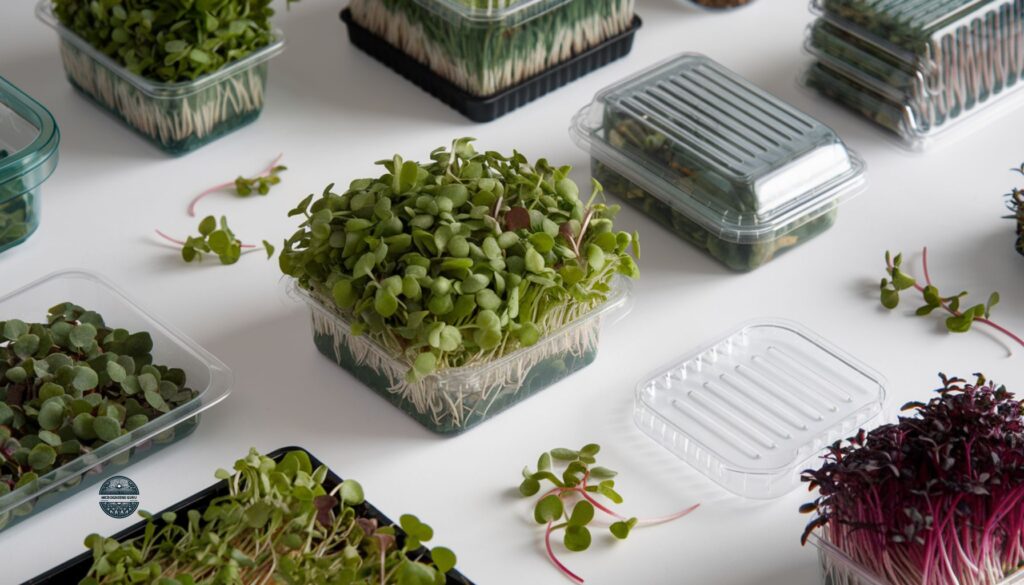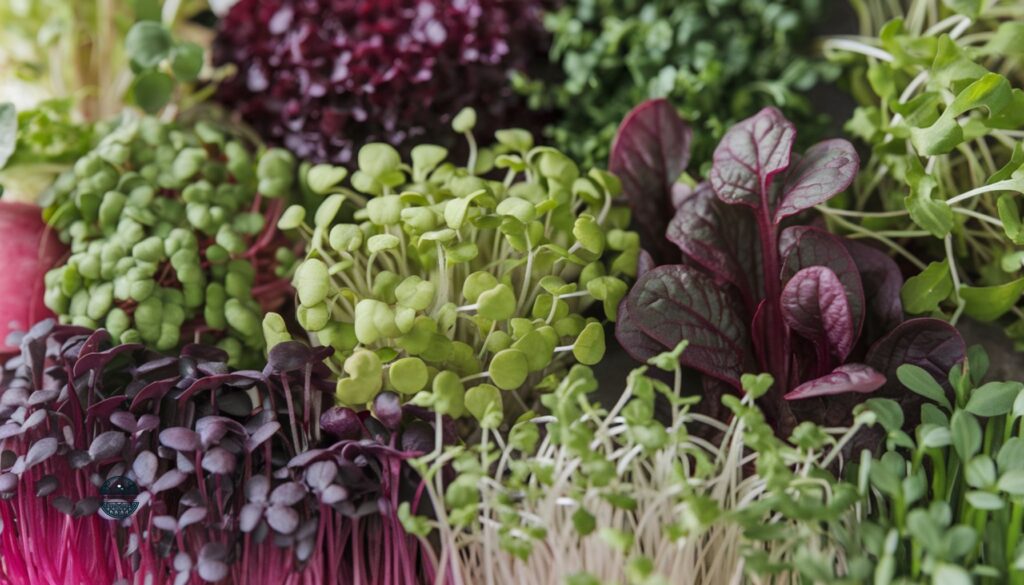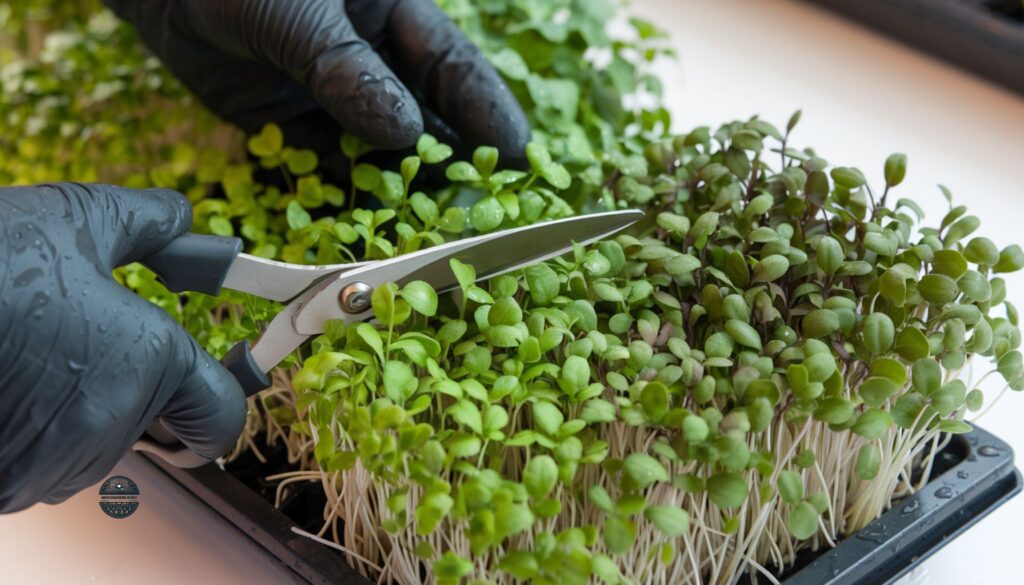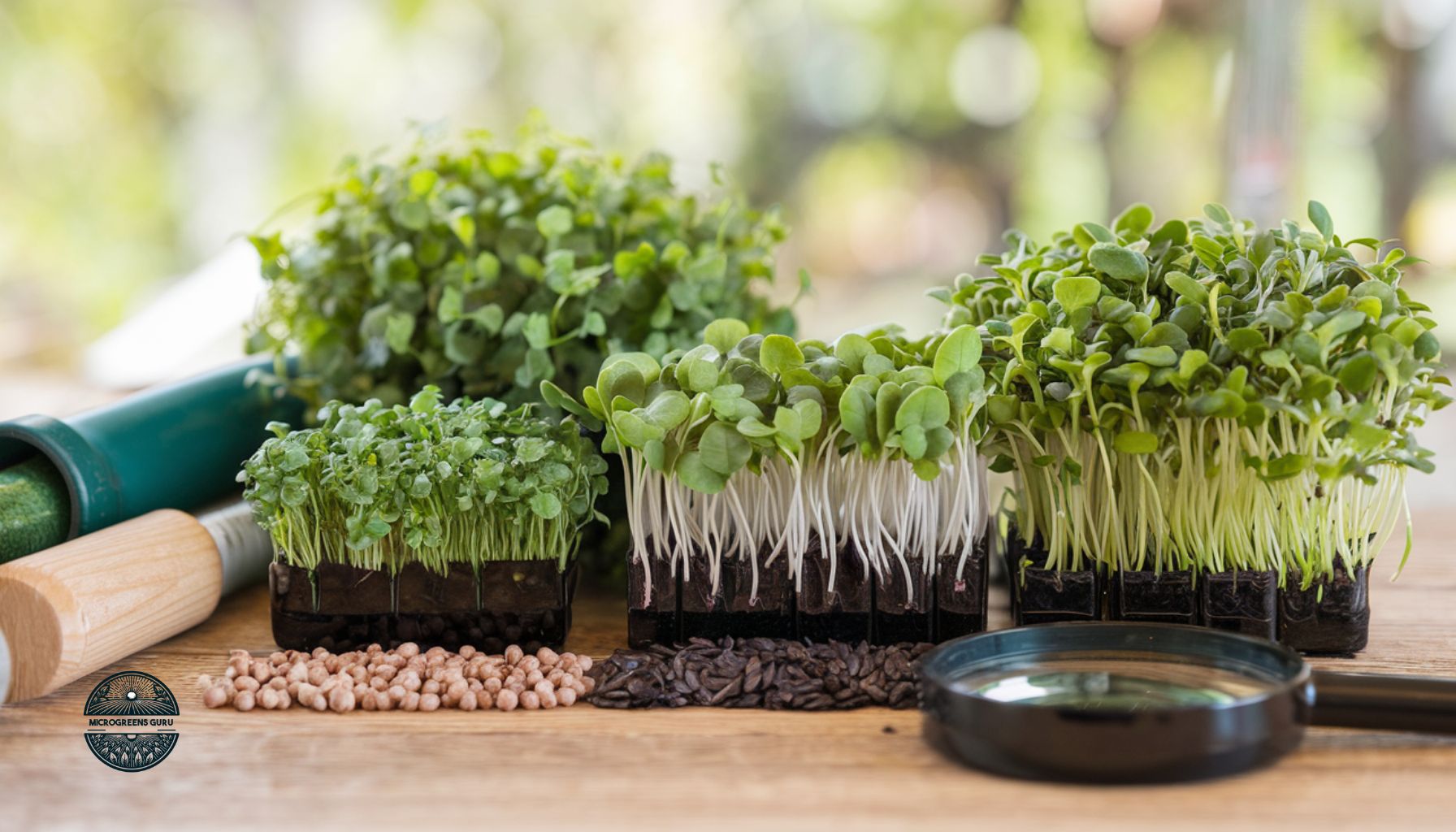Do You Really Need a Label for Your Microgreens?
Some of our posts on Microgreensguru.com contain affiliate links. If you click on an affiliate link and make a purchase, we may receive a commission. Clicking on an affiliate link that earns a commission does NOT result in additional charges or costs you extra. Earnings from affiliate links help keep this website running. See our full affiliate disclosure here.
Ever gazed at your lush tray of microgreens and wondered if they need their own tiny billboards?
Labeling microgreens might seem like overkill at first glance – after all, they’re just itty-bitty plants, right?
But hold onto your garden gloves, because there’s more to this mini-veggie marketing than meets the eye. From FDA regulations that’ll make your head spin faster than a salad spinner to cutting-edge tech that might make you feel like you’re growing greens on Mars, the world of microgreen labeling is a wild ride.
Whether you’re a small-scale grower sharing your harvest with neighbors or dreaming of microgreen mogul status, understanding labeling can be the difference between a flourishing green business and a wilted dream.
So, grab your magnifying glass (because these labels can get pretty small) and get ready to explore the surprisingly complex world of microgreen labeling and get the answer to “Do you really need a label for your microgreens”? Your tiny greens might just thank you for giving them a voice – even if it’s in 6-point font.
Key Takeaways
- Federal and state regulations play a big role in determining labeling requirements for microgreens.
- Labeling isn’t just about following rules; it’s a powerful tool for building consumer trust and enhancing your product’s value.
- Even when labels aren’t legally required, they can be beneficial for traceability and food safety.
- Common labeling mistakes can lead to regulatory issues and consumer confusion – but they’re easily avoidable with the right knowledge.
- Innovative labeling technologies are transforming how we think about product information and transparency.
- Different microgreen varieties may have specific labeling considerations, especially when it comes to mixed products.
Understanding Microgreen Labeling Regulations
Regulations are the spice of life! (Or, is that cilantro microgreens?) Either way, when it comes to labeling your miniature veggie friends, there’s a whole garden of rules to navigate.
Federal Regulations: The Big Kahunas
First up, we’ve got the FDA – yes, the same folks who make sure your dog food isn’t actually made of old shoes. They’ve got some thoughts on microgreen labeling, and by “thoughts,” I mean “rules you’d better follow unless you want a very stern letter.”
The FDA says your microgreen labels should include:
- Product name (e.g., “Sunflower Microgreens” – not “Tiny Sun Sprouts of Joy”)
- Net weight (because “a handful” isn’t an FDA-approved unit of measurement)
- Your business name and address (so they know where to send that stern letter)
- Harvest date (to prove your greens aren’t old enough to vote)
But wait, there’s more!
If you’re feeling extra fancy and want to slap “organic” on that label, you’ll need to deal with the USDA. They’re like the bouncers at the organic club, and they don’t mess around. You’ll need certification faster than you can say “pesticide-free.”
State and Local Regulations: The Plot Thickens
Just when you thought you had it all figured out, along come state and local regulations to add some extra seasoning to your labeling soup. These can vary more than the flavors in a microgreen mix, so you’ll want to check with your local authorities.
Take California, for example. They’re like the overachieving sibling of states when it comes to regulations. In the Golden State, you might need a permit from your local health department just to sell your microgreens. It’s like getting a driver’s license for your lettuce.

Microgreens by the Numbers: A Leafy Look at the Market
Before we dive deeper into the nitty-gritty of labeling, let’s take a moment to appreciate just how big this tiny greens business has become. These stats are about to make your microgreens look macro!
| Statistic | Value | Notes | Source |
|---|---|---|---|
| Global Market Size (2020) | $824.4 million | Estimated value of the global microgreens market | [1] |
| Projected CAGR (2024-2030) | 8.7% | Compound Annual Growth Rate for the microgreens market | [1] |
| Expected Market Value (2022) | $1.7 billion | Projected value of the microgreens market | [1] |
| Hand Washing Compliance | 95.5% | Percentage of farms reporting routine hand washing during production | [4] |
| Small-Scale Growers | Majority | Most respondents were small-scale growers (less than $10,000 per year in revenue) | [5] |
| New Market Entrants | Majority | Most respondents entered the market within the last 10 years | [5] |
Who knew these little leaves could make such big waves? From a market value that’s sprouting faster than a radish microgreen to food safety practices that would make even the strictest health inspector nod in approval, it’s clear that microgreens are no small potatoes in the world of agriculture.
But here’s the kicker: with great market size comes great responsibility. As the microgreens industry continues to grow like a well-watered tray of sunflower shoots, proper labeling becomes more crucial than ever. After all, you wouldn’t want your thriving microgreens empire to get tangled up in regulatory weeds, would you?

The Microgreen Label Checklist: Your Ticket to Compliance City
It’s time for the moment you’ve all been waiting for – the ultimate microgreen label checklist. Think of this as your backstage pass to the rock concert of regulatory compliance. Ready to make your labels sing?
Always-On-the-Label All-Stars:
- Product name (e.g., “Sunflower Microgreens” – not “Sunny’s Fun-Sized Foliage”)
- Net weight (because “a handful” isn’t an FDA-approved unit of measurement)
- Your business name and address (so fans can send fan mail… or the FDA can send inspectors)
- Harvest date (to prove your greens aren’t old enough to vote)
- “Best by” date (typically within a week, unless you’ve discovered the fountain of eternal crispness)
- Storage instructions (e.g., “Keep refrigerated” – not “Store in a cool, dark place like a vampire’s lair”)
- Ingredient list (if you’re fancy and mixing things up)
- Allergen information (because some folks are allergic to awesome)
- Origin (where your greens grew up and went to school)
- Lot number (for those “just in case” moments)
- Any required statements (e.g., “Made in a Home Kitchen” if you’re living the home-based hustle)
The “Depending on Your Situation” Superstars:
- Nutritional information (unless you’re exempt, in which case, party on!)
- Organic certification info (if you’re claiming organic status – no fibbing allowed!)
- Growing method (soil-grown, hydroponic, or grown by tiny garden gnomes)
- Health or safety warnings (e.g., “Caution: May cause sudden outbursts of health and happiness”)
Remember, this list is your new best friend. Treat it like that one friend who always remembers your birthday – with love, respect, and maybe a little eye-rolling at their perfectionism.
And, here’s the kicker. Rules can vary depending on where you’re selling, how much you’re selling, and who you’re selling to. It’s like a game of regulatory Twister, but with less falling over (hopefully). So, always check with your local authorities to make sure you’re hitting all the right notes in the complex symphony of microgreen compliance.
Now, armed with this checklist, go forth and label like the microgreen rockstar you are! Your tiny greens are ready for their close-up, and your labels are their Hollywood agents. Lights, camera, compliance!
Microgreens Labeling Essentials
Product Information
Include product name, net weight, and business name/address on your microgreens label.
Dates and Storage
Clearly state harvest date, best-by date, and storage instructions for freshness.
Regulatory Compliance
Ensure labels meet FDA guidelines and include any required statements or certifications.
Consumer Education
Use labels to inform customers about microgreen varieties, nutrition, and usage tips.
When Labels Are Mandatory: The “You Better Do This” List
Let’s get down to the nitty-gritty. When do you absolutely, positively, no-doubt-about-it need to label your microgreens?
- Commercial Sales: If you’re selling your microgreens to the public, congratulations! You’re also selling them to the world of mandatory labeling.
- Interstate Commerce: Planning to ship your greens across state lines? Better label them, unless you want your microgreens to star in their own episode of “Border Security.”
- Organic Certification Claims: If you’re claiming your microgreens are organic, you better have the label to back it up. The USDA doesn’t take kindly to organic posers.
Circumstances Where Labels May Not Be Required: The “You Might Get Away With It” List
Believe it or not, there are times when you can let your microgreens go commando (label-wise, that is).
- Direct, Small-Scale Local Sales: Selling to your neighbors or at a small local market? You might be able to skip the formal labeling. Just don’t be surprised if Mrs. Johnson from next door starts demanding a nutrition facts panel.
- Personal Use and Home Growing: Growing for yourself? Unless you have a very strict personal chef, you probably don’t need to label your home-grown goodies.
- Sales Below Certain Thresholds: Some regulations have exemptions for small-scale producers. It’s like a “get out of labeling free” card, but with more fine print.
The Evolution of Microgreens: From Niche to Mainstream
Craig Hartman coins the term “Microgreens” and the concept spreads across the American restaurant industry.
Craig Hartman’s friend Michael Clark accidentally grows and delivers extremely small greens.
Pam Parseghian, a food writer from Nation’s Restaurant News, visits Hartman’s restaurant and writes about microgreens.
The story about microgreens is published in Nation’s Restaurant News, spreading the concept across the American restaurant industry.
Michael Clark presents microgreens at a large seminar for hydroponic equipment manufacturers, attended by 300-400 people, including the founders of Chef’s Garden.
Microgreens start appearing on restaurant menus more widely.
Nancy Roe publishes the article “Growing Microgreens: Maybe the Ultimate Specialty Crop,” exploring the niche world of microgreen cultivation.
The demand for healthy food options drives the growth of microgreens in the market.
The microgreens market is valued at approximately USD 824.4 million.
The global microgreens market size reaches around USD 2.59 billion with favorable growth forecasts.
Microgreens are expected to grow at a CAGR of 10.60%, reaching a market value of USD 1.74 billion in the US.
The global microgreens market is projected to reach USD 2.6 billion with a CAGR of 11%.
Benefits of Labeling (Even When Not Required): The “Why Not?” List
Even if you’re not legally required to label your microgreens, there are some pretty good reasons to do it anyway:
- Building Consumer Trust: A good label is like a firm handshake for your microgreens. It says, “Hello, I’m a responsible and transparent product. Nice to meet you!”
- Enhancing Product Value: A well-designed label can make your microgreens look fancier than a salad at a five-star restaurant.
- Ensuring Food Safety and Traceability: If there’s ever an issue, a good label can help trace it faster than you can say “recall.”

Essential Information for Microgreen Labels: The “Don’t Forget This Stuff” List
If you’re going to label (and you probably should), here’s what you need to include:
- Product name (get creative, but keep it accurate)
- Net weight (in both ounces and grams, because we’re inclusive like that)
- Your business name and address (in case someone wants to send you fan mail)
- Harvest date (to prove your greens are fresher than a daisy)
- Best-by date (because even microgreens have an expiration date)
- Storage instructions (unless “leave on counter until wilted” is your recommended method)
Challenges in Microgreen Labeling: The “Why Is This So Hard?” Section
Labeling microgreens isn’t all sunshine and perfectly printed stickers. There are some challenges:
- Space Constraints: Ever tried to fit the entire history of agriculture on a 2-inch label? Welcome to the world of microgreen packaging.
- Balancing Compliance with Marketing: You need to follow the rules AND make your product look irresistible. It’s like trying to make a rabbit hutch look like the Taj Mahal.
- Keeping Up with Changing Regulations: Just when you think you’ve got it figured out, the rules change. It’s like playing regulatory whack-a-mole.
Best Practices for Microgreen Labeling: The “Do This and You’ll Be Fine” Guide
- Keep it clear and legible. Your customers shouldn’t need a magnifying glass to read your labels.
- Be consistent. If you’re using “oz” on one product, don’t switch to “ounces” on another. Pick a style and stick to it.
- Use high-quality, water-resistant labels. Your microgreens are going to live in the fridge, not the Sahara.
- Include a QR code for additional information. It’s like giving your microgreens their own website!
Innovative Labeling Solutions and Emerging Technologies: The “Future Is Now” Section
Hold onto your garden gloves, because the world of labeling is getting a high-tech makeover!
- Edible Ink and Labels: Yes, you read that right. Edible ink is a thing, and it’s making waves in the food industry. Imagine printing directly on your microgreens! Okay, maybe not directly on them, but on edible rice paper or something similar. It’s like giving your greens a tasty tattoo.
- Biodegradable Labels: For when you want your labels to be as eco-friendly as your microgreens. These labels will break down faster than your New Year’s resolutions.
- Smart Labels: QR codes are just the beginning. We’re talking labels that can change color to indicate freshness, or display real-time supply chain information. It’s like your microgreens have their own social media profile.
- AI and Blockchain: Artificial Intelligence and blockchain technology are entering the labeling game. Soon, your microgreen labels might be smarter than some people you know. They could update themselves with real-time data, track the entire journey of your greens from seed to sale, and maybe even predict the future. Okay, maybe not that last part, but who knows?

Common Labeling Mistakes and How to Avoid Them: The “Don’t Be That Guy” Guide
- Misrepresentation of Organic Status: Don’t call it organic unless you’ve got the papers to prove it. The USDA doesn’t appreciate green-washing.
- Incorrect Weight Measurements: “About a handful” is not an accepted unit of measurement. Invest in a good scale.
- Misleading Health Claims: Your microgreens are awesome, but they probably can’t cure baldness or grant eternal youth. Stick to claims you can back up.
- Incomplete Product Information: Forgetting to include your contact info is like sending a letter without a return address. How will your fans find you?
- Unclear Allergen Information: Some people are allergic to sunflower seeds. Who knew? Make sure to mention potential allergens.
- Improper Use of Terminology: A microgreen is not a sprout is not a baby green. Know your terms!
Labeling for Different Microgreen Varieties: The “Not All Greens Are Created Equal” Section
Different microgreens might need different labeling approaches. Here’s a quick rundown:
- Broccoli Microgreens: Mention that sulforaphane content. It’s like a superhero power for these little greens.
- Radish Microgreens: Don’t forget to warn about the spicy kick. Some people might think they’re getting mild greens and end up with a radish rave in their mouth.
- Sunflower Microgreens: Highlight that nutty flavor and remind folks about potential allergens.
For mixed microgreen products, list all varieties in order of predominance. It’s like creating a guest list for the world’s tiniest, healthiest party.
Product Recommendations: The “You’re Gonna Need This Stuff” List
Now that we’ve filled your head with more labeling knowledge than you ever thought possible, let’s talk about some products that can help you put all this info into practice:
- DYMO Label Maker LabelManager 210D: This handheld label maker is perfect for small-scale microgreen operations. It’s like a tiny printer that fits in your pocket!
- ROLLO Label Printer: For those of you running a larger operation, this bad boy can print shipping labels, product labels, and probably your family Christmas cards if you ask it nicely.
- Waterproof Vinyl Labels: These labels will stick to your containers tighter than a microgreen root clings to its growing medium.
- Food Rotation Labels: These dissolvable labels are perfect for tracking harvest dates and ensuring your microgreens are always at peak freshness.
- Reusable Chalkboard Labels: For the environmentally conscious grower, these labels let you update information without creating waste. Plus, they look pretty darn cute.
Remember, the right tools can make labeling feel less like a chore and more like… well, slightly less of a chore. But hey, it’s all part of the journey to microgreen stardom!
More Gadgets and Gizmos: The “I Can’t Believe It’s Not Butter Lettuce” Collection
Just when you thought we were done, here comes another helping of labeling gadgetry! Because let’s face it, in the world of microgreens, there’s no such thing as too many toys… er, tools.
- Digital Kitchen Scale: For when “a pinch” and “a handful” don’t cut it anymore. This scale is so precise, it can measure the weight of your microgreens’ hopes and dreams.
- Inkjet Printer for Food-Safe Edible Ink: Ever wanted to print directly on your microgreens? No? Well, now you can anyway! It’s like giving your greens temporary tattoos, but tastier.
- Label Design Software: Because MS Paint just doesn’t cut it for FDA-compliant labels. This software is so user-friendly, even your cat could design labels (results may vary).
- QR Code Generator: For when you want your microgreens to have their own website. It’s like social media for salad!
- Thermal Printer for Compostable Labels: Labels that break down faster than your composting resolutions. Mother Nature will high-five you for this one.
- Portable Light Box: For when you need to take glamour shots of your labels. Because your microgreens deserve their own Instagram account.
- Label Applicator Machine: For those days when your hand cramps up from applying labels manually. It’s like a label-dispensing robot, minus the world domination plans.
- Barcode Scanner: To make your microgreen operation feel like a real grocery store. Beep your way to success!
- Weather-Resistant Label Covers: Because sometimes your labels need their own raincoats. Protect them from the elements like the delicate divas they are.
- Label Removal Tool: For when you realize you’ve spelled “microgreens” as “macro greens” on 1000 labels. Oops!
Remember, with great labeling power comes great responsibility. Use these tools wisely, and may the microgreen force be with you!
Further Reading: The “Down the Rabbit Hole” Collection
Fancy seeing you here at the bottom of our labeling adventure. But what’s this? You’re still hungry for more microgreen knowledge? Your thirst for green wisdom is truly inspiring! We’ve cultivated a list of articles that’ll take you deeper into the world of microgreens than you ever thought possible. Grab your reading glasses and maybe a snack (might we suggest some microgreens?), because you’re in for a wild ride!
- Microgreens Packaging Ideas: Innovative Ways to Make Your Greens Stand Out – Because your microgreens deserve to dress for success!
- Do I Need a License to Sell Microgreens? Dispelling Myths, Unveiling Truths – Spoiler alert: It’s more complicated than getting a license for your dog, but less complicated than quantum physics.
- Decoding FDA Guidelines for Microgreens: A Comprehensive Guide for Growers – Warning: May cause sudden urges to become a microgreen legal expert.
- Best Microgreens to Sell: Discover the Top Varieties Consumers Can’t Resist – Find out which microgreens are the Beyoncés of the plant world.
- How Much Can You Make Selling Microgreens? Explore the Financial Upside of Green Thumbs – Spoiler: It’s probably not “buy your own island” money, but it might be “buy a really nice salad spinner” money.
There you have it,. Enough reading material to keep you busy until your next microgreen harvest (or at least until your eyes start to cross). Remember, knowledge is power, but too much knowledge might just turn you into that person at parties who won’t stop talking about the proper pH levels for radish microgreens. Don’t be that person. Or do. We don’t judge.
Frequently Asked Questions About Labeling Microgreens:
Q: Do I really need FDA approval to sell microgreens?
A: While you don’t need direct FDA approval, you do need to comply with FDA guidelines for growing, harvesting, and labeling produce. It’s like following the rules of the road, but for tiny vegetables.
Q: Can I sell microgreens on Amazon?
A: You sure can! But remember, selling online often means stricter labeling requirements. Make sure your labels are ready for their close-up before you hit that “list item” button.
Q: Is selling microgreens still profitable in 2025?
A: According to market projections, the U.S. microgreens market is expected to reach $2.86 billion by 2029. That’s a lot of tiny greens! So yes, there’s still plenty of green in growing greens.
Test Your Knowledge: AI Milestones
Final Thoughts: Are You Ready to Label Your Microgreens?
Congratulations. You've successfully navigated the labyrinthine world of microgreen labeling. From federal regulations to futuristic smart labels, you're now armed with more labeling knowledge than you ever thought possible.
Remember, whether you're a small-scale grower sharing your harvest with neighbors or a microgreen mogul shipping cross-country, proper labeling is more than just following rules.
It's about building trust, showcasing your awesome product, and maybe even having a little fun with design (just don't go too crazy – we don't want the FDA knocking on our door).
At Microgreens Guru, we're all about helping you grow the best microgreens possible and that includes making sure they're labeled to perfection.
So, go forth and label with confidence! Your microgreens deserve nothing less than the best.
And, hey, if you've got any wild labeling stories, creative label designs, or if you just want to share your microgreen journey, we'd love to hear from you!
Drop us a line, send us a carrier pigeon, or better yet, label a microgreen with your message and see if it reaches us. (Okay, maybe don't do that last one. But you get the idea.)
Now, if you'll excuse me, I need to go label my lunch. You never know when the FDA might stop by for a sandwich inspection!

Cal Hewitt is the Founder and Lead Cultivator at Microgreens Guru, a website dedicated to empowering individuals to grow, consume, and potentially sell nutrient-dense microgreens. With 5 years of hands-on experience in microgreens cultivation, Cal brings a unique analytical perspective to the world of urban agriculture. He specializes in optimizing growth techniques for various microgreen varieties, while also focusing on sustainable and cost-effective growing methods. Cal’s passion for microgreens, ignited by a personal health journey, drives him to continuously explore and share innovative approaches to microgreens cultivation. His practical experience, combined with his commitment to education through his website and upcoming book, ensures that Microgreens Guru remains a valuable resource for both novice and experienced growers alike.






















